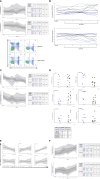Radiation immunodynamics in patients with glioblastoma receiving chemoradiation
- PMID: 39346903
- PMCID: PMC11427284
- DOI: 10.3389/fimmu.2024.1438044
Radiation immunodynamics in patients with glioblastoma receiving chemoradiation
Abstract
Introduction: This is a prospective, rigorous inquiry into the systemic immune effects of standard adjuvant chemoradiotherapy, for WHO grade 4, glioblastoma. The purpose is to identify peripheral immunologic effects never yet reported in key immune populations, including myeloid-derived suppressor cells, which are critical to the immune suppressive environment of glioblastoma. We hypothesize that harmful immune-supportive white blood cells, myeloid derived suppressor cells, expand in response to conventionally fractionated radiotherapy with concurrent temozolomide, essentially promoting systemic immunity similar what is seen in chronic diseases like diabetes and heart disease.
Methods: 16 patients were enrolled in a single-institution, observational, immune surveillance study where peripheral blood was collected and interrogated by flow cytometry and RNAseq. Tumor tissue from baseline assessment was analyzed with spatial proteomics to link peripheral blood findings to baseline tissue characteristics.
Results: We identified an increase in myeloid-derived suppressor cells during the final week of a six-week treatment of chemoradiotherapy in peripheral blood of patients that were not alive at two years after diagnosis compared to those who were living. This was also associated with a decrease in CD8+ T lymphocytes that produced IFNγ, the potent anti-tumor cytokine.
Discussion: These data suggest that, as in chronic inflammatory disease, systemic immunity is impaired following delivery of adjuvant chemoradiotherapy. Finally, baseline investigation of myeloid cells within tumor tissue did not differ between survival groups, indicating immune surveillance of peripheral blood during adjuvant therapy may be a critical missing link to educate our understanding of the immune effects of standard of care therapy for glioblastoma.
Keywords: brain tumor; chemoradiotherapy; glioblastoma; immune system; radiotherapy.
Copyright © 2024 Sloan, Sen, Liu, Doucet, Blosser, Katulis, Kamson, Grossman, Holdhoff, Redmond, Quon, Lim, Eberhart, Pardoll, Hu, Ganguly and Kleinberg.
Conflict of interest statement
LS: Research Support- GT Medical Technologies. MH: Data Safety Monitoring Board- Parexel and Advarra; Advisory Board- Servier; Speaking Engagement- Novartis. KR: Research Grant- Elekta AB, Accuray; Honoraria- AstraZeneca, Accuray, NCCN; Travel Expenses- Elekta AB, Accuray, Brainlab, Icotec. ASTRO; Unpaid volunteer for the University of Maryland branch of Camp Kesem- Camp Kesem. ML: Research Support- Arbor, BMS, Accuray, Biohaven, Urogen; Consultant-VBI, InCephalo Therapeutics, Merck, Pyramid Bio, Insightec, Biohaven, Sanianoia, Hemispherian, Novocure, Noxxon, InCando, Century Therapeutics, CraniUs, MediFlix, XSense, Stryker; Shareholder- Egret Therapeutics; Patent- Focused radiation + checkpoint inhibitors, local chemotherapy + checkpoint inhibitors, checkpoints for neuro-inflammation; DSMB – Cellularity. LaK: Research support- BMS, Incyte, Novartis, and Novocure; Study steering committee for Novocure. The remaining authors declare that the research was conducted in the absence of any commercial or financial relationships that could be construed as a potential conflict of interest.
Figures




Similar articles
-
Immune modulation associated with vascular endothelial growth factor (VEGF) blockade in patients with glioblastoma.Cancer Immunol Immunother. 2017 Mar;66(3):379-389. doi: 10.1007/s00262-016-1941-3. Epub 2016 Dec 9. Cancer Immunol Immunother. 2017. PMID: 27942839 Free PMC article.
-
Tumor cell and immune cell profiles in primary human glioblastoma: Impact on patient outcome.Brain Pathol. 2021 Mar;31(2):365-380. doi: 10.1111/bpa.12927. Epub 2021 Feb 13. Brain Pathol. 2021. PMID: 33314398 Free PMC article.
-
Initial experience with scalp sparing radiation with concurrent temozolomide and tumor treatment fields (SPARE) for patients with newly diagnosed glioblastoma.J Neurooncol. 2020 May;147(3):653-661. doi: 10.1007/s11060-020-03466-z. Epub 2020 Mar 23. J Neurooncol. 2020. PMID: 32206976 Clinical Trial.
-
Immature myeloid cells in the tumor microenvironment: Implications for immunotherapy.Clin Immunol. 2018 Apr;189:34-42. doi: 10.1016/j.clim.2016.10.008. Epub 2016 Oct 21. Clin Immunol. 2018. PMID: 27777083 Free PMC article. Review.
-
Crosstalk Between Tumor-Associated Microglia/Macrophages and CD8-Positive T Cells Plays a Key Role in Glioblastoma.Front Immunol. 2021 Jul 29;12:650105. doi: 10.3389/fimmu.2021.650105. eCollection 2021. Front Immunol. 2021. PMID: 34394072 Free PMC article. Review.
Cited by
-
Long-Term Survival Analysis of Neoadjuvant Chemoradiotherapy Versus Adjuvant Chemoradiotherapy for Locally Advanced Low Rectal Cancer.Cancer Med. 2025 Aug;14(15):e71042. doi: 10.1002/cam4.71042. Cancer Med. 2025. PMID: 40709606 Free PMC article.
-
Overcoming temozolomide resistance in glioma: recent advances and mechanistic insights.Acta Neuropathol Commun. 2025 Jun 5;13(1):126. doi: 10.1186/s40478-025-02046-4. Acta Neuropathol Commun. 2025. PMID: 40468460 Free PMC article. Review.
-
Spatial omics technology potentially promotes the progress of tumor immunotherapy.Br J Cancer. 2025 Sep;133(4):421-434. doi: 10.1038/s41416-025-03075-5. Epub 2025 Jun 2. Br J Cancer. 2025. PMID: 40456924 Review.
References
-
- Stupp R, Hegi ME, Mason WP, van den Bent MJ, Taphoorn MJ, Janzer RC, et al. . Effects of radiotherapy with concomitant and adjuvant temozolomide versus radiotherapy alone on survival in glioblastoma in a randomised phase III study: 5-year analysis of the EORTC-NCIC trial. Lancet Oncol. (2009) 10:459–66. doi: 10.1016/S1470-2045(09)70025-7 - DOI - PubMed
-
- Kleinberg L, Grossman SA, Piantadosi S, Zeltzman M, Wharam M. The effects of sequential versus concurrent chemotherapy and radiotherapy on survival and toxicity in patients with newly diagnosed high-grade astrocytoma. Int J Radiat Oncol Biol Phys. (1999) 44:535–43. doi: 10.1016/S0360-3016(99)00060-7 - DOI - PubMed
-
- Yovino S, Kleinberg L, Grossman SA, Narayanan M, Ford E. The etiology of treatment-related lymphopenia in patients with Malignant gliomas: modeling radiation dose to circulating lymphocytes explains clinical observations and suggests methods of modifying the impact of radiation on immune cells. Cancer Invest. (2013) 31:140–4. doi: 10.3109/07357907.2012.762780 - DOI - PMC - PubMed
Publication types
MeSH terms
Substances
LinkOut - more resources
Full Text Sources
Medical
Research Materials

